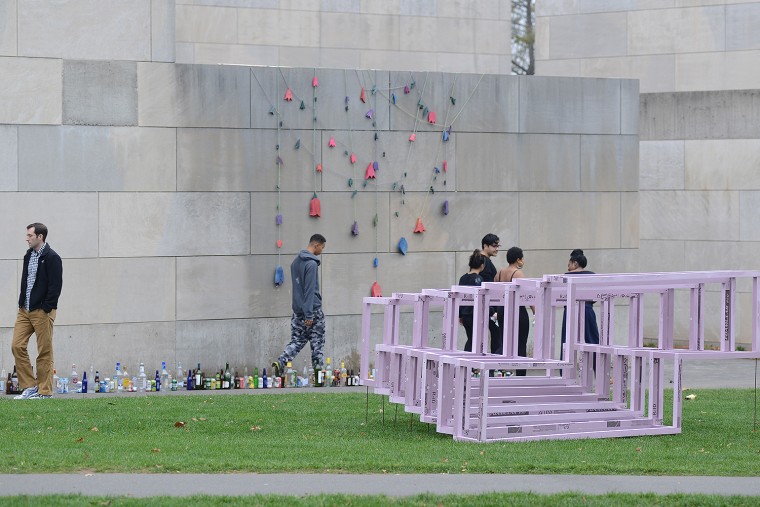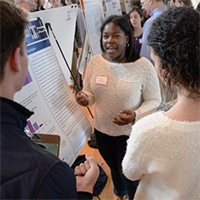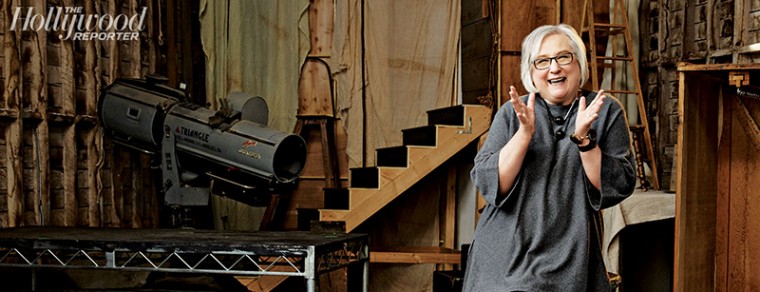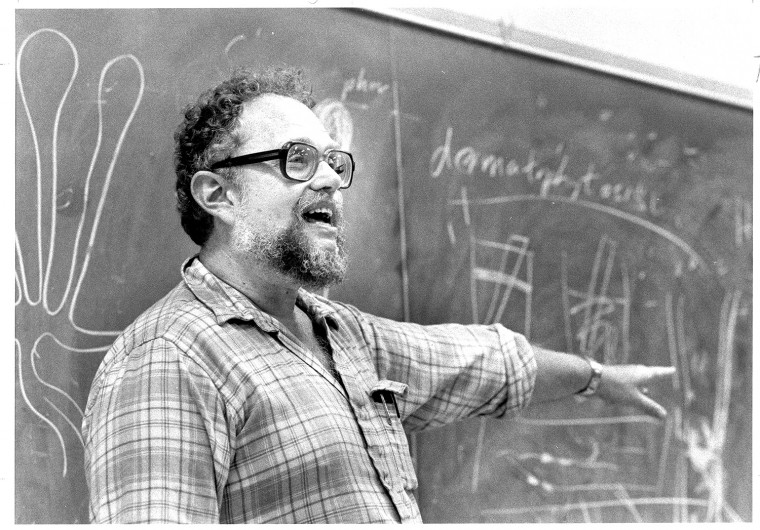The historic global deal on climate change reached by 190 countries in Paris will help the economy, not hurt it as critics argue, writes Huffington Foundation Professor of Economics and Environmental Studies Gary Yohe in an op-ed in The Hartford Courant. "The evidence in the peer-reviewed economic literature, as well as real experience around the world and in the United States, shows that climate action not only protects public health by reducing pollution, but also protects the economy from extreme weather shocks and other complications that have and will arise from a changing climate. The sooner we act, the more money…
Students enrolled in Sculpture I and Studies in Computer-Based Modeling and Digital Fabrication displayed their art around the Center for the Art's public spaces Dec. 12-16. Sculpture I, taught by Professor of Art Jeffrey Schiff, is an introduction to seeing, thinking and working in three dimensions. Throughout the semester, the class examined three-dimensional space, form, materials and the associations they elicit. Through the sculptural processes of casting, carving and construction in a variety of media, students developed and communicated a personal vision in response to class assignments. Projects included janitorial supplies hanging in suspension, plastic color shapes making a stain-glass window, electronic components…
Professor and Chair of Religion Mary-Jane Rubenstein was a guest on PRI's "Studio 360" to discuss the history of scientific thinking on multiple universes. Though scientists today are becoming increasingly interested in thinking about multiple universes, the idea actually dates back about 2,500 years to the Atomist philosophers of Ancient Greece. Rubenstein discussed how the Atomists arrived at a theory of multiple universes: For the ancient Atomist philosophers, the most desirable thing about what we're now calling the multiverse was that it got rid of the need for a god. If it is the case that our world is the only…
Alcohol use, traffic fines and race, and the impact of caffeine on sleep were among the topics presented at a poster session in which students enrolled in a project-based course at the Quantitative Analysis Center demonstrated the power of statistical analysis to illuminate social problems. The QAC Student Research Poster Session, held Dec. 11 in Beckham Hall, served as a final exam for students taking QAC 201: Applied Data Analysis. Several Wesleyan faculty and alumni evaluated the students’ poster presentations. Funded by the National Science Foundation, the QAC 201 class allows students to spend a semester studying a topic they are passionate about. They learn to generate hypotheses…
Jeanine Basinger, Corwin-Fuller Professor of Film Studies, was recently featured in a Hollywood Reporter article “The Professor of Hollywood,” by film historian and best-selling author Sam Wasson ’03, who studied with Basinger at Wesleyan. The magazine brought together 33 of her former pupils who work prominently in the film industry for “an A-list class reunion” photo—and several of them talk about how Basinger inspired them, encouraging their self-expression while also sharing with them her love for the medium. In the article, Basinger discusses how and why she came to devote her life to the study of film and how working…
New York rapper and music producer Khalif Daoud ’11, known professionally as Le1f, was one of the musicians polled by WBUR-Boston and NPR’s Here & Now with the question “What is American music?” “Growing up, the idea of ‘Americana’ as a word was intimidating to me,” he told hosts Robin Young and Jeremy Hobson. “The patriotism behind it, and the American dream, I always related that to whiteness and I didn’t easily see how I fit into that category, that culture. But I came to understand that blues and jazz and rock and roll, and all these other genres, that’s…
On Dec. 5, Wesleyan students, faculty and the local community gathered for a two-hour discussion on "Indigenous Middletown: Settler Colonial and Wangunk Tribal History." The event was sponsored by the American Studies Department, the Center for the Americas, and the Allbritton Center for the Study of Public Life. J. Kehaulani Kauanui, associate professor of anthropology, associate professor of American studies, coordinated the event, which stemmed from her Service Learning course, Decolonizing Indigenous Middletown: Native Histories of the Wangunk Indian People. The class is in partnership with the Middlesex County Historical Society. (more…)
A collaborative project by Assistant Professor of Music Roger Matthew Grant was listed in New York Times' co-chief art critic Holland Cotter's Top 10 list of Best in Art. Grant served as the dramaturg and also performed in the installation of "The Magic Flute," a revamped version of Mozart's original at New York University's Steinhardt School of Culture, staged by 80WSE Gallery and the Cheap Kollectiv of Berlin. "This was theater for mind and senses," writes Cotter, describing it as "packed with magic." Part one of "The Magic Flute," an opera in six steps, was in open rehearsals Dec. 1–5. Part two, a film…
Every year we review dozens of books and publish several author essays, and a book excerpt or two, by Wesleyan alumni in the pages of Wesleyan magazine. With the holidays upon us, 'tis the season to take another look at just a handful of the many selections made by Wesleyan magazine Arts and Culture Editor David Low this year. Happy reading! (more…)
Readers who are fans of urban history and planning or have a particular interest in New York should find City on a Grid: How New York Became New York (Da Capo) by Gerard Koeppel ’79 a fascinating read. Koeppel shares the story behind the Manhattan street grid, created in 1811 by a three-man commission featuring headstrong Founding Father Gouverneur Morris; the plan called for a dozen parallel avenues crossing at right angles with many dozens of parallel streets in an unbroken grid. When the grid plan was announced, New York was just under 200 years old, an overgrown town and…
William "Bill" Firshein, the Daniel Ayres Professor of Biology, emeritus, died Dec. 7 at the age of 85. Firshein arrived at Wesleyan in 1958 after receiving his BS from Brooklyn College and his MS and PhD from Rutgers University. He taught at Wesleyan for 47 years before retiring in 2005. Firshein was an active scholar who was awarded research grants totaling more than $2 million over his career. He investigated the molecular biology of DNA replication cell division in Bacillus subtilis and Escherichia coli and their plasmids. In his most recent book, The Infectious Microbe, published by Oxford University Press…
Tom Goodman’s (’69) career in photography has spanned many different mediums. From being a full-time photographer, an instructor, to operating an agency, Goodman has always been fascinated by the art of photography. After graduating Wesleyan with an honors degree in art, he went on to earn his MFA in photography from the University of New Mexico, which was the catalyst that launched his career. In 1975 he was hired by the University of Texas at San Antonio to develop the photography program. Three years later he moved to Philadelphia to teach at the University of the Arts (then the Philadelphia College…







